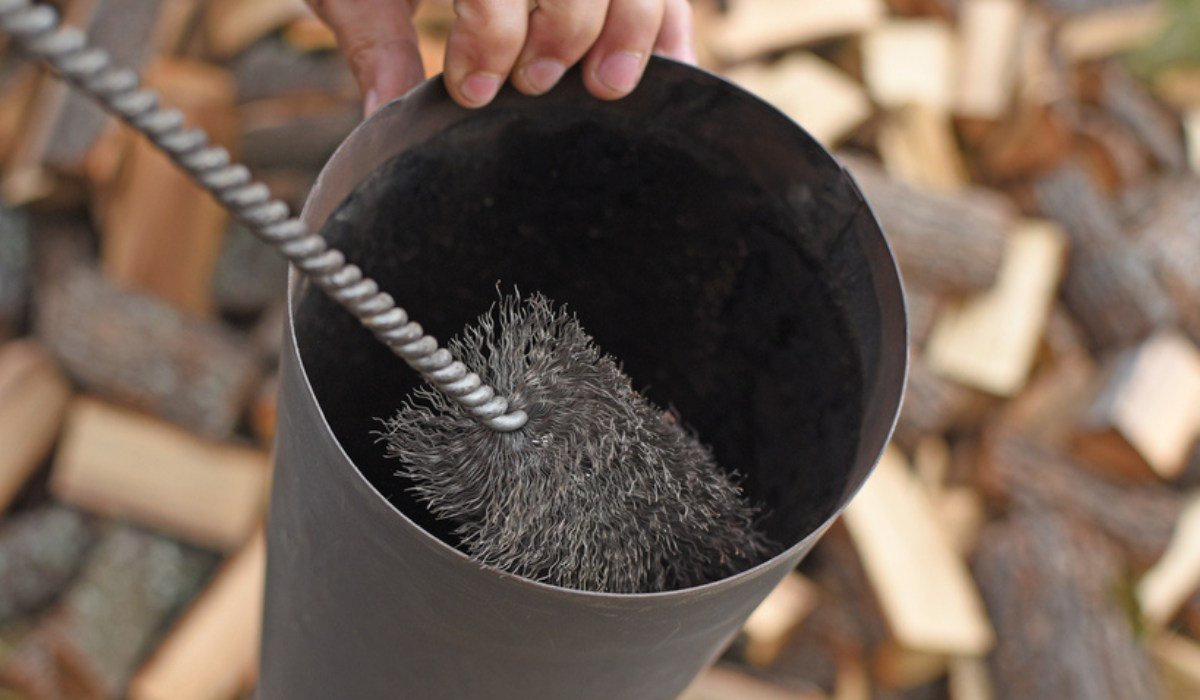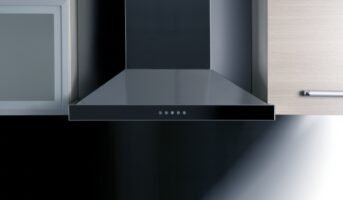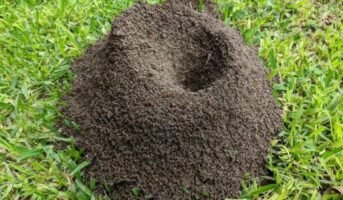In the winter, a fireplace or wood stove will keep your house toasty while saving you money on heating oil or electricity. However, if you use wood for heating and need help remembering the last time you cleaned your chimney, it is probably past due. A chimney must be cleaned to eliminate soot, obstructions, and creosote accumulation. An unclean chimney might lead to spontaneous chimney fires.
A chimney should typically be cleaned twice a year. However, the kind of wood you burn and how frequently you use your stove may necessitate more frequent cleaning.
See also: Best chimney design ideas for your kitchens

Source: Pinterest
Can I clean my chimney?
You can begin cleaning a chimney on your own, depending on your physical condition and the state of your chimney. You can complete the task yourself if your chimney is regularly cleaned and there is not much creosote accumulation, and you have the right tools.
A chimney can be cleaned from the interior of your house or top-down (from the roof). If your roof is incredibly steep or you cannot use a ladder, you should clean your chimney inside your house or hire a professional.
Chimney cleaning: Detailed instructions
DIY chimney cleaning is feasible if you have the necessary safety precautions and are physically competent to work from your roof. Check the condition of your chimney and the amount of cleaning necessary before starting. Using a flashlight and mirror to gaze up from the fireplace or the cleanout on the exterior of your home, you can examine your chimney from the bottom up.
The finest view is typically found on the roof. In this situation, you will need to take off the chimney cover so you can shine a flashlight into the flue. You may follow these instructions to properly clean your chimney if your duct is in good condition.
Obtain the proper tools
To choose the appropriate brush size, measure the flue liner’s diameter. A brush that is a quarter to a half inch more than the chimney diameter is recommended. You will also need these to run extension rods throughout the entire length of your chimney.
Set up your work area
Protecting your home from harm is crucial whether you are working inside or from the roof. Make sure the wood stove door is shut tightly. Remove any irons, grates, or other accessories from the firebox if you have a fireplace. Cover the fireplace entrance with heavy-duty plastic sheeting and duct tape if you will be working from the roof to keep soot and debris contained. Lastly, if you are cleaning inside the house, cover the floor and any nearby furniture to prevent falling soot and particles.
Clean the flue
It would be best to open the damper before cleaning, regardless of your cleaning technique.
Utilising the roof to work
Before mounting a ladder, ensure you have all the necessary tools and safety equipment. As you climb, designate a partner to keep the ladder steady. Set up a shop where you can securely operate on the roof. Remove the chimney cap for cleaning if you replaced it after the inspection. To remove soot and flaky creosote, insert the brush into the chimney, push it down, scrub up and down, and then spin the brush clockwise.
When necessary, add extension rods as you go down the chimney. Remove the brush after thoroughly cleaning the flue, taking apart the rods as you go.
Work from within
You may clean the chimney from the bottom if your fireplace is large enough for your upper body. It would help to prepare yourself for a filthy task by wearing appropriate clothing. To protect yourself against falling debris:
- Put on a face mask and safety glasses.
- With the wire brush, reach up into the flue and the fireplace.
- Use a brush to scrub the flue walls up and down.
- Add additions as necessary until you reach the chimney’s top.
After cleaning is finished, remove the brush from the chimney while removing any extensions.
Complete cleaning
Give the dust and debris from the flue some time to settle before cleaning the chimney. To access the regions of your fireplace that a chimney brush could not reach, carefully remove any covers. Clean the smoke shelf thoroughly with a wire brush or a tiny chimney brush. Before using a shop vac to remove all of the dust and debris, wait for the dust to settle once again.
Chimney cleaning: When to get your chimney cleaned by a professional?
The pleasure of a fireplace or wood-burning stove comes with significant obligations to safeguard your property. An important aspect of upkeep that may help you safeguard your house is chimney cleaning. When heated, the extremely flammable substance creosote may easily catch fire. The temperature of a chimney fire can rise to 2,000 degrees Fahrenheit, which is high enough to cause the chimney’s masonry liners to break and ignite nearby wood framing or roofing materials.
Many people prefer to hire a professional when cleaning a chimney, but you may do it yourself under the correct conditions. Professional chimney cleaning normally ranges from Rs 9360 to Rs 64,000, with an average cost of Rs 37,600. However, removing thick creosote buildup frequently calls for specialised equipment and techniques. If your chimney’s creosote has built up into a thick coating that restricts airflow, it is advisable to call an expert as soon as possible for cleaning.
Chimney cleaning: Advantages
- The chimney’s effectiveness is increased
Keeping your chimney clean reduces your risk of having a house fire. Fewer obstacles in its route will help your wood burner operate as well as possible. It maintains effective heating to keep your room as warm as is practical, in addition to keeping your family comfortable and reducing your need for extra heating systems.
After cleaning, the fireplace cleaning services will provide optimal air ventilation. It limits the amount of energy that flames may use to burn.
- It prevents chimney fires
No dangerous fire risk exists in a home with a clean fireplace and chimney. In order to prevent sparks or flames from reaching creosote, a highly flammable black or dark brown residue that accumulates as a consequence of combustion, it is cleaned correctly during chimney cleaning.
The risk of fire automatically diminishes when the firebox, smoke chamber above the firebox, smoke shelf, flue, and flue liner are all clean.
- Lessens and prevents the negative health effects of creosote
Creosote is harmful to your health. There is a chance that the creosote-filled flue lining in your chimney will flake off, fall into the firebox, or even create dust inside your home. The creosote dust can cause a variety of health problems, such as respiratory problems, organ damage if consumed, skin and eye irritation, and respiratory problems.
- Lower your heating costs
Everyone likes to save money since it is important for living comfortably. Maintaining the health and functionality of your chimney will be greatly aided by power washing or other yearly chimney cleanings. You can avoid any accumulation, whether it comes from the weather or the gases that enter the chimney, by keeping your chimney clean.
Additionally, it will keep your home looking its best and increase the value of your home.
- Lengthen the chimney’s lifespan
An effective chimney is one that is clean. Anything’s lifespan rises when it is maintained. It applies to everything we use in life, not just the chimney. The lifetime and maintenance of things are directly related. If you have frequent cleaning plans, the number of years the chimney is expected to last will now be greater.
FAQs
How often should a chimney be cleaned?
It is generally recommended to have your chimney cleaned at least once a year, especially if you use it frequently. However, the actual frequency of cleaning will depend on factors such as the type of fuel you burn, the size of your chimney, and how often you use it.
How do I know if my chimney needs cleaning?
There are a few signs that may indicate your chimney needs cleaning. These include:
(1) Difficulty in starting a fire
(2) Smoke fills the room
(3) A strong odour when burning wood
(4) Excess creosote buildup on the chimney walls
Can I clean my chimney myself?
It is possible to clean a chimney yourself, but it can be a dangerous and time-consuming task. It is generally recommended to hire a professional chimney sweep who has the necessary training, experience and equipment to safely and effectively clean your chimney.
Housing News Desk is the news desk of leading online real estate portal, Housing.com. Housing News Desk focuses on a variety of topics such as real estate laws, taxes, current news, property trends, home loans, rentals, décor, green homes, home improvement, etc. The main objective of the news desk, is to cover the real estate sector from the perspective of providing information that is useful to the end-user.
Facebook: https://www.facebook.com/housing.com/
Twitter: https://twitter.com/Housing
Email: [email protected]











